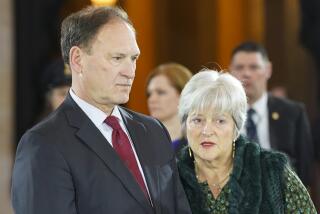Enemies in High Places : FORTAS: The Rise and Ruin of a Supreme Court Justice<i> by Bruce Allen Murphy (William Morrow: $24.95; 717 pp., illustrated; 0-688-0357-2) </i>
Political scandal has been a given of American life for 120 years. Since Ulysses S. Grant won the White House in 1868, resignations and indictments of government officials have plagued both parties. Boss Tweed, the Whiskey Ring, the Credit Mobilier, Teapot Dome, Harry Vaughan, Sherman Adams, Bobby Baker, Watergate and the Iran-Contra affair are only among the more memorable of these cases.
The resignation of Associate Justice Abe Fortas from the Supreme Court in 1969 is another chapter in the history of American public embarrassments.
The offspring of a poor immigrant Jewish family in Memphis, Tenn., Fortas lived a classic rags-to-riches story. A driven student with an exceptionally good mind, Fortas attended Southwestern College in Memphis on a scholarship before gaining admission to the Yale Law School in 1930.
Compiling a brilliant record and winning the support of William O. Douglas, a faculty member, Fortas followed Douglas to Washington, where both enjoyed strikingly successful careers--Douglas as a Supreme Court justice beginning in 1939, and Fortas, after service in F.D.R.âs Interior Department, as a leading attorney at the firm of Arnold, Fortas, and Porter.
A friend and legal adviser to Lyndon B. Johnson, whom he helped win a court fight for a Texas Senate seat in 1948, Fortas entered L.B.J.âs circle of intimates.
Fortasâ uncommon legal talents and political liberalism made him Johnsonâs first choice for appointment to the Supreme Court. But the lack of a vacancy and Fortasâ reluctance to leave his lucrative law practice barred the way.
In 1965, in a dazzling display of his persuasive powers, Johnson persuaded Associate Justice Arthur Goldberg to become ambassador to the United Nations and Fortas to replace Goldberg on the court.
Johnson induced Goldberg to leave the bench by tempting him with the vice presidency in a second Johnson term, and he overcame Fortasâ reluctance by insisting that, like the boys in Vietnam, Fortas had to serve.
âIf your President asks you to do something for your country, can you run out on him?â Johnson asked.
In June, 1968, after Johnson had declared himself out of the running for another term and 77-year-old Chief Justice Earl Warren had announced his intention to retire, Johnson nominated Abe Fortas for the job. During the next four months, attacks on Fortas for permissiveness on pornography cases and for extrajudicial activities sank his nomination.
Opposition to Fortas as a symbol of the liberal Warren Court would not have been enough to defeat him. But revelations that he had violated the separation-of-powers doctrine by counseling the Administration on a variety of problems and that he had compromised himself by accepting a large payment for teaching a seminar at American University were.
In the next year, revelations fostered by the Nixon Administration about Fortasâ ties to Louis E. Wolfson, a wealthy businessman convicted of illegal stock manipulations, led Fortas to resign from the court.
Bruce Allen Murphyâs book is the first major scholarly assessment of Fortasâ life. A professor of political science at Pennsylvania State University and author of a ground-breaking book on the secret political activities of Supreme Court Justices Louis D. Brandeis and Felix Frankfurter, Murphy was well prepared to address the complicated story of Fortasâ failed nomination as chief justice and resignation from the court.
Although described as a biography, Murphyâs book is primarily a study of how and why Fortas was defeated in 1968-69. It is a deeply researched, considered account that adds fresh details to what we previously knew and draws judicious and persuasive conclusions that will become the starting point for all future reassessments of the case.
Through extensive interviews and archival research, Murphy effectively reconstructs the story of Fortasâ extrajudicial activities, the Johnson Administrationâs unsuccessful strategy in the Senate confirmation fight, and the considerable involvement of the Nixon Administration in forcing Fortas off the court.
Murphy sees many things at work in Fortasâ demise. His avarice, arrogance, and deceitfulness were important elements in the story.
But, Murphy says, âgreed, ambition, normative insensitivity, occasional dishonesty and overconfidence are not normally fatal diseases in Washington. If they were, the city would now be empty.â
While these contributed to Fortasâ ruin, the deeper âproblem was that Fortas became the wrong man, in the wrong place, at the wrong time.â Fortasâ transgressions were not unique: Other justices had histories of extrajudicial activities similar to his.
However, âit was not just what Fortas did, but how and when he did it.â While Fortas made himself vulnerable to attack, it was a set of circumstances beyond his control that ultimately determined his fate.
Johnsonâs dying presidency, the shift from liberalism to conservatism, and the resurgence of congressional power against the imperial presidency came together in 1968-69 to destroy Fortasâ judicial career.
Murphyâs discussion of the Fortas case is superb, but it will not be the last word on Fortas. Murphyâs more-than-600-page book has too little to say about Fortasâ judicial opinions for that. Murphy justifies the omission by saying that his is a âpolitical biography,â and besides, Fortas issued ârelatively few opinions in his brief (4-year) judicial career.â
Nevertheless, as Murphy points out, there has been almost no writing on Fortasâ legal views. Moreover, as a symbol of the Warren Court, Fortas and his judicial opinions deserve more attention than they have received.
In time, we will surely get a biography that more fully takes these matters into account. But when we do, it is unlikely to improve upon Murphyâs description and analysis of the most arresting aspect of Fortasâ life--the âmurder-suicideâ of his Supreme Court career.
More to Read
Sign up for Essential California
The most important California stories and recommendations in your inbox every morning.
You may occasionally receive promotional content from the Los Angeles Times.










